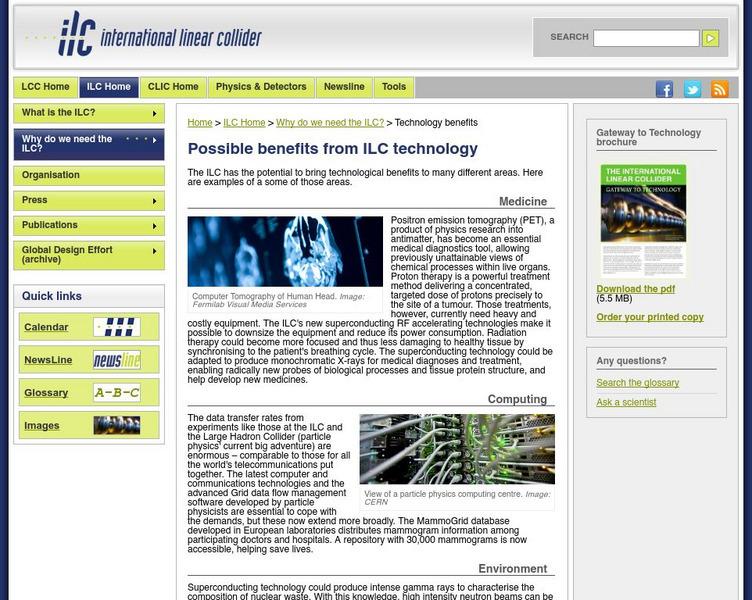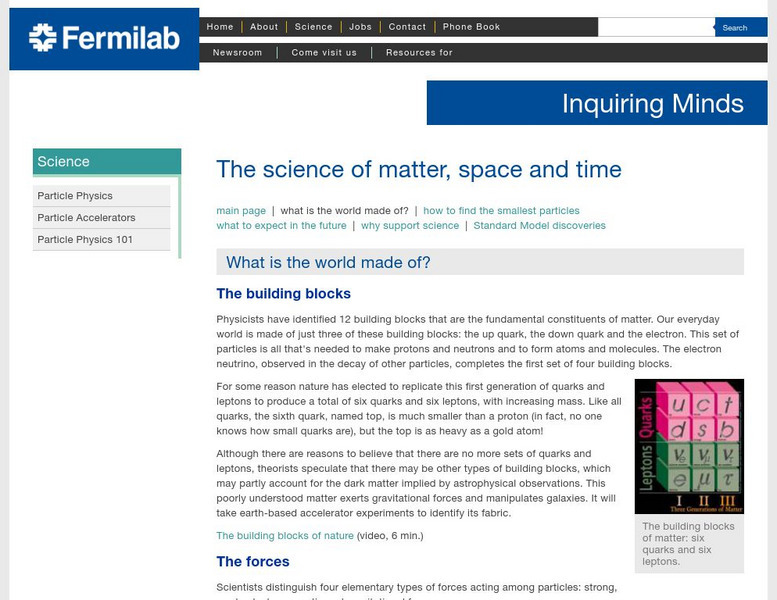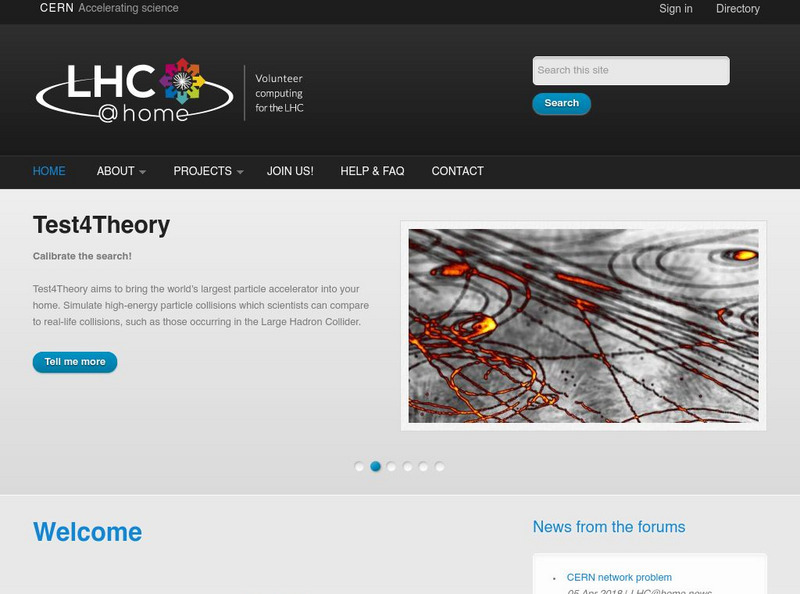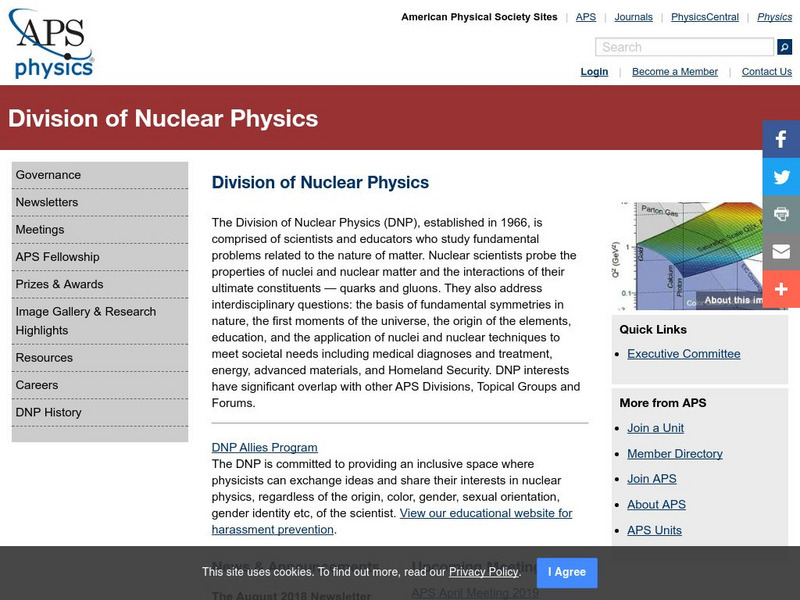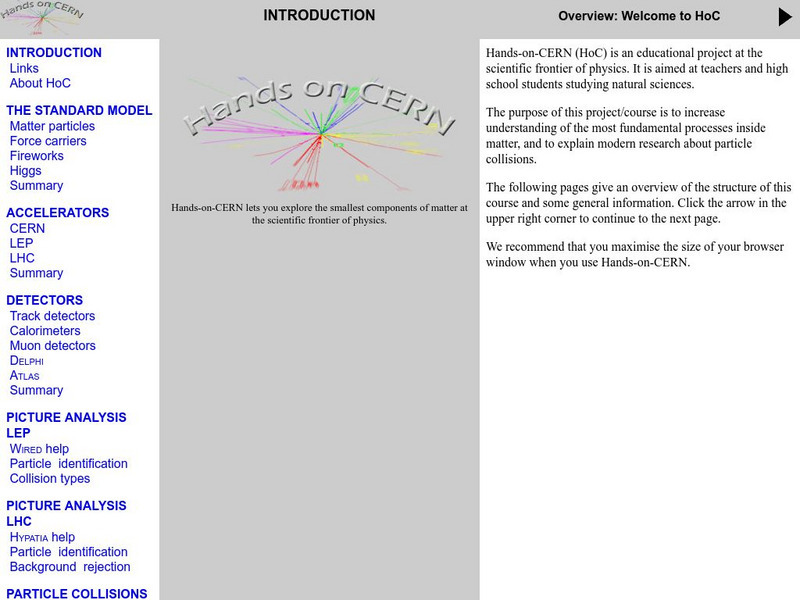Other
Particles, Special Relativity and Quantum Mechanics
Quantum physics, despite its inherent weirdness, is thus far the best model physicists have for explaining the universe. This site gives a great overview of the principles of quantum mechanics and gives scenarios to help the reader...
Other
International Linear Collider: Possible Benefits From Ilc Technology
Research with linear colliders may enormously benefit fields such as medicine, computing and the environment. Examples include medical proton therapy and the potential of being able to render nuclear waste harmless. A wonderful side...
University of Cambridge
University of Cambridge: Physics: The Neutron
This site provides a great series on the neutron discovered by James Chadwick. Includes a seven-page series that covers what is inside the nucleus, the elusive neutron, beryllium radiation, Chadwick's discovery, neutrons from beryllium,...
Other
Greek Philosophy: Leucippus and Democritus
This article provides an overview of the atomistic philosophy of the pre-Socratic philosophers Leucippus and Democritus in the 5th and 4th centuries, BCE.
National High Magnetic Field Laboratory
Magnet Academy: Murray Gell Mann
Murray Gell-Mann is a theoretical physicist who won the Nobel Prize for Physics in 1969 for his contributions to elementary particle physics. He is particularly well known for his role in bringing organization into the world of subatomic...
Other
Fermilab: What Is the World Made Of?
An introduction to the building blocks of matter, and the forces that interact among them. There is also brief discussion of antimatter and the standard model. This resource has numerous links to additional physics topics.
Other
European Organization for Nuclear Research: Lhc@home: The Lhc
A basic explanation of the Large Haldron Collider, a particle accelerator near Geneva, works.
Famous Scientists
Famous Scientists: Albert Einstein
Read a short biography about Albert Einstein, and find out how he discovered the general theory of relativity.
Famous Scientists
Famous Scientists: Chen Ning Yang
Learn about the Nobel Prize winning physicist who works on statistical mechanics and particle physics.
Famous Scientists
Famous Scientists: Ernest Rutherford
This short biography about Ernest Rutherford explains how he became known as the father of nuclear chemistry and physics.
CK-12 Foundation
Ck 12: Physical Science: Fundamental Particles
[Free Registration/Login may be required to access all resource tools.] Investigates fundamental particles and their discovery, and how they relate to fundamental forces.
Nobel Media AB
The Nobel Prize: Sheldon Glashow Biographical
Autobiography of Sheldon Glashow, one of three men to win the 1979 Nobel Prize for Physics.
NASA
Nasa: Imagine the Universe: Gamma Rays From Supernovae and Supernova Remnants
Astronomers use gamma decay to study the lives of the stars.
Other
American Physical Society: Division of Nuclear Physics
This is the homepage of the American Physical Society's Division of Nuclear Physics. There are links to information on careers, research, degree programs, etc.
Lawrence Berkeley National Laboratory
Berkeley Lab: Phases of Nuclear Matter
A brief explanation of determining the temperature and density at which the critical point of nuclear matter is located.
Science Struck
Science Struck: What Is the Higgs Boson Particle?
A detailed explanation of the Higgs Boson particle and the science of particle physics. Discusses the history of the search for this particle, the ongoing research with the Large Hadron Collider at CERN in Europe, and what is known so...
Other
Hands on Cern: Explore the Smallest Components of Matter
An online course in particle physics with colorful images, charts and animations. Begin by learning about the Standard Model and the types of particles, particle families, and forces, then carry this knowledge over to your study and...
The Wonder of Science
The Wonder of Science: Ms Ps1 1: Atomic Composition Model
A collection of lesson plans for helping students understand atomic composition. Site uses work samples, phenomena, assessment templates, and videos to plan lessons to describe the atomic composition of simple molecules.
TED Talks
Ted: Ted Ed: String Theory and the Hidden Structures of the Universe
What is everything made of? Thus far, we can break everything in the universe down to a few very small elementary particles. But they fit into strange patterns that are not understood. Clifford Johnson describes these ideas, along with...
Famous Scientists
Famous Scientists: Brian Cox
Learn about the life and work of English pop star-turned-physicist, Brian Cox.
Khan Academy
Khan Academy: Applying Gravity to a Particle
Understand how we simulate the effect of gravity on a particle.
Khan Academy
Khan Academy: Step 1 (Particle Under Gravity)
This program simulates a particle falling due to gravity. Try changing the initial settings. What do you think will happen if you... Increase gravity? Change the mass of the particle? Make the time step negative?
Khan Academy
Khan Academy: Start: How Do Computers Simulate the Motion of Virtual Particles?
In this lesson we'll explore how we use fairly simple physics to draw particles which move according to the forces we feel in the real world (such as wind & gravity).
Khan Academy
Khan Academy: Applying Gravity to a Particle
Next, let's apply all these ideas to the case where a particle is being acted on by both gravity and air resistance using this 5-question quiz/practice. The gravity force vector points downward, and the air resistance force opposes it.



